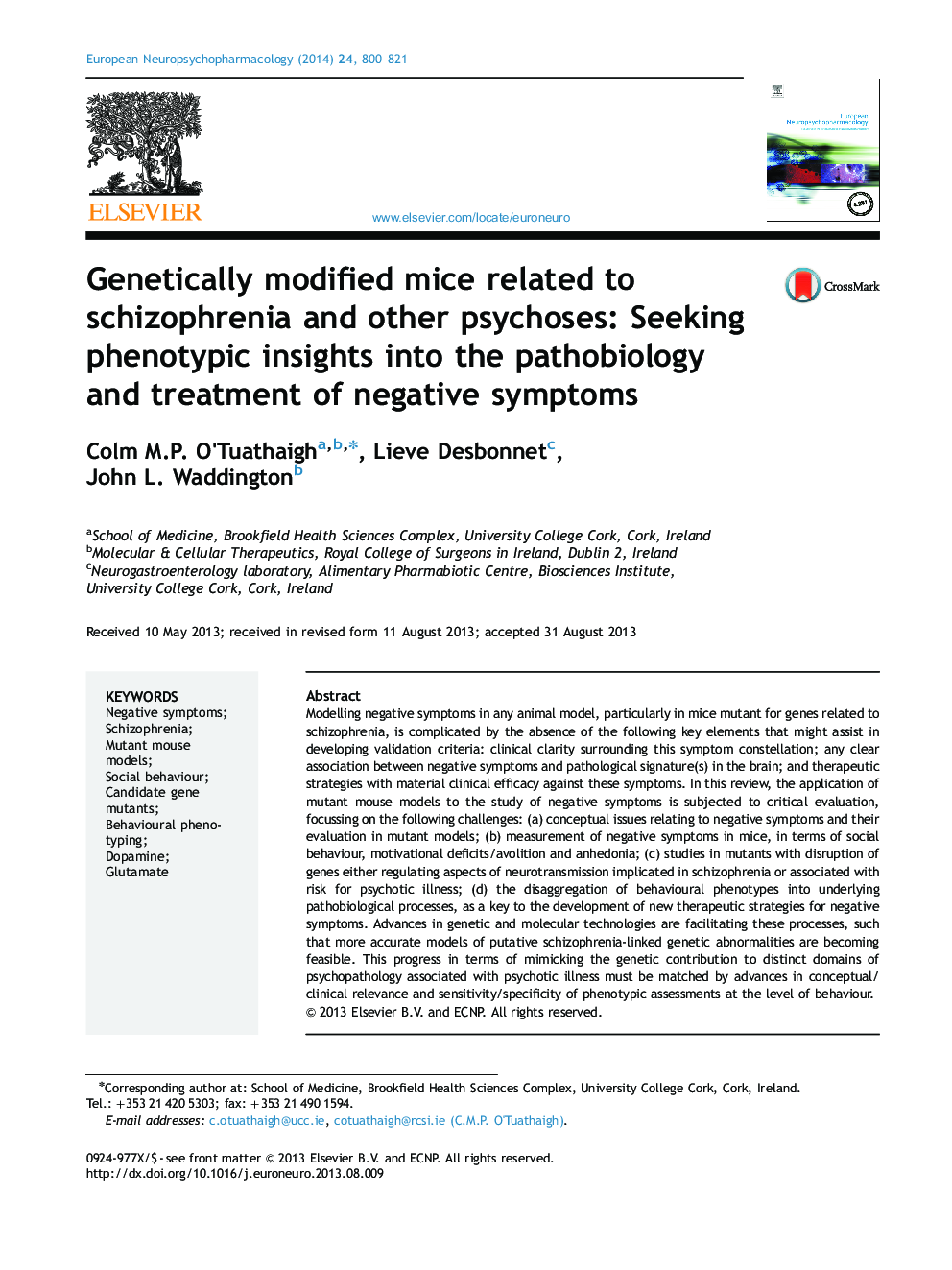| کد مقاله | کد نشریه | سال انتشار | مقاله انگلیسی | نسخه تمام متن |
|---|---|---|---|---|
| 10299020 | 539679 | 2014 | 22 صفحه PDF | دانلود رایگان |
عنوان انگلیسی مقاله ISI
Genetically modified mice related to schizophrenia and other psychoses: Seeking phenotypic insights into the pathobiology and treatment of negative symptoms
ترجمه فارسی عنوان
موش های اصلاح شده ژنتیکی مرتبط با اسکیزوفرنیا و سایر روانپزشکی: جستجوی بینش های فنوتیکی به پاتوبیولوژی و درمان علائم منفی
دانلود مقاله + سفارش ترجمه
دانلود مقاله ISI انگلیسی
رایگان برای ایرانیان
کلمات کلیدی
علائم منفی، جنون جوانی، مدل ماوس جهش یافته، رفتار اجتماعی، جهش ژن کاندید فنوتیپی رفتاری، دوپامین، گلوتامات
ترجمه چکیده
مدل سازی علائم منفی در هر مدل حیوانی، به ویژه در موتانت موشهای ژن های مرتبط با اسکیزوفرنی، با عدم وجود عناصر کلیدی زیر که ممکن است در توسعه معیارهای اعتبار سنجی کمک کند: وضوح بالینی در اطراف این صورتحساب علامت؛ هر گونه ارتباط روشن بین علائم منفی و امضاهای پاتولوژیک (مغز) در مغز؛ و استراتژی های درمانی با کارآیی بالینی مواد در برابر این علائم. در این بررسی، استفاده از مدل های جهش جهش یافته به بررسی علائم منفی تحت ارزیابی انتقادی قرار می گیرد و با تمرکز بر چالش های زیر مطرح می شود: الف) مسائل مفهومی مربوط به علائم منفی و ارزیابی آنها در مدل جهش یافته؛ (ب) اندازه گیری علائم منفی در موش ها، از لحاظ رفتار اجتماعی، کسری انگیزشی / انحراف و اندونی؛ (ج) مطالعات در موتانت ها با اختلال ژن یا تنظیم جنبه های انتقال عصبی مرتبط با اسکیزوفرنی یا همراه با خطر ابتلا به بیماری روانگردان؛ (د) تجزیه فنوتایپ های رفتاری به فرآیندهای پاتوبیولوژیکی پایه به عنوان کلید توسعه راهبردهای درمانی جدید برای علائم منفی. پیشرفت در تکنولوژی های ژنتیک و مولکولی، این پروسه ها را تسهیل می کند، به طوری که مدل های دقیق تر از اختلالات ژنتیکی مرتبط با اسکیزوفرنی قابل پیش بینی امکان پذیر می شوند. این پیشرفت با توجه به تقلید از مشارکت ژنتیکی در حوزه های متمایز بیماری های روانپزشکی مرتبط با بیماری روانگردان، باید با پیشرفت در ارتباط مفهومی / بالینی و حساسیت / ویژگی ارزیابی فنوتیپ در سطح رفتار مطابقت داشته باشد.
موضوعات مرتبط
علوم زیستی و بیوفناوری
علم عصب شناسی
روانپزشکی بیولوژیکی
چکیده انگلیسی
Modelling negative symptoms in any animal model, particularly in mice mutant for genes related to schizophrenia, is complicated by the absence of the following key elements that might assist in developing validation criteria: clinical clarity surrounding this symptom constellation; any clear association between negative symptoms and pathological signature(s) in the brain; and therapeutic strategies with material clinical efficacy against these symptoms. In this review, the application of mutant mouse models to the study of negative symptoms is subjected to critical evaluation, focussing on the following challenges: (a) conceptual issues relating to negative symptoms and their evaluation in mutant models; (b) measurement of negative symptoms in mice, in terms of social behaviour, motivational deficits/avolition and anhedonia; (c) studies in mutants with disruption of genes either regulating aspects of neurotransmission implicated in schizophrenia or associated with risk for psychotic illness; (d) the disaggregation of behavioural phenotypes into underlying pathobiological processes, as a key to the development of new therapeutic strategies for negative symptoms. Advances in genetic and molecular technologies are facilitating these processes, such that more accurate models of putative schizophrenia-linked genetic abnormalities are becoming feasible. This progress in terms of mimicking the genetic contribution to distinct domains of psychopathology associated with psychotic illness must be matched by advances in conceptual/clinical relevance and sensitivity/specificity of phenotypic assessments at the level of behaviour.
ناشر
Database: Elsevier - ScienceDirect (ساینس دایرکت)
Journal: European Neuropsychopharmacology - Volume 24, Issue 5, May 2014, Pages 800-821
Journal: European Neuropsychopharmacology - Volume 24, Issue 5, May 2014, Pages 800-821
نویسندگان
Colm M.P. O'Tuathaigh, Lieve Desbonnet, John L. Waddington,
